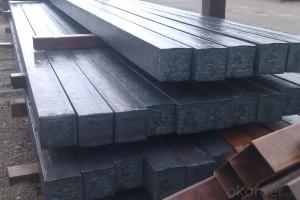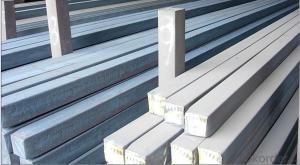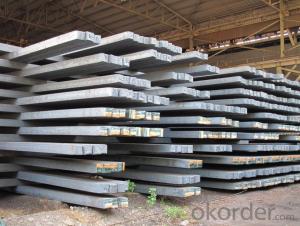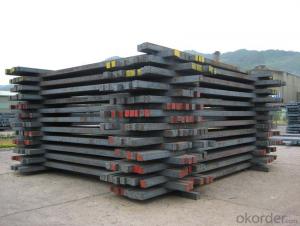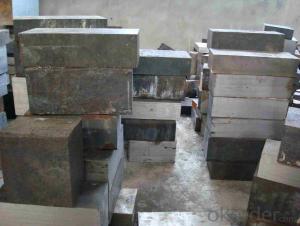Hot Rolled Square Steel Billet 3SP Standard 135mm
- Loading Port:
- Shanghai
- Payment Terms:
- TT OR LC
- Min Order Qty:
- 2000 m.t.
- Supply Capability:
- 10000 m.t./month
OKorder Service Pledge
OKorder Financial Service
You Might Also Like
Structure of Hot Rolled Square Steel Billet 3SP Standard 135mm

Description of Hot Rolled Square Steel Billet 3SP Standard 135mm
PPGI is made by cold rolled steel sheet and galvanized steel sheets as baseplate, through the surface pretreatment (degreasing, cleaning, chemical conversion processing), coated by the method of continuous coatings (roller coating method),
and after roasting and cooling. Zinc coating: Z60, Z80, Z100, Z120, Z180, Z275, G30, G60, G90
Alu-zinc coating: AZ60, AZ80, AZ100, AZ120, AZ180, G30, G60, G90
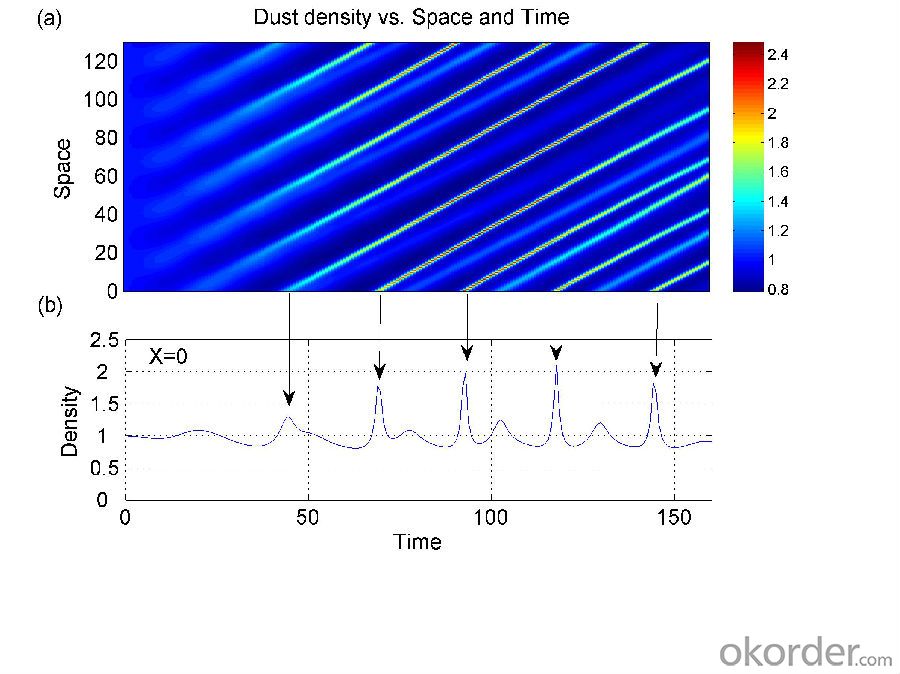
Main Feature of Hot Rolled Square Steel Billet 3SP Standard 135mm
1) Excellent corrosion resistance: The zinc layer provides a good protection of Pre-painted Galvanizeed Steel Sheet.
2) High heat resistance: The reflective surface of the material aids in efficiently reflecting the sunlight away and in turn reducing the amount of heat transmitted. The thermal reflectivity converts into energy savings.
3) Aesthetics: Pre-Painted Galvanized steel sheet is available in plethora of patterns and multiple sizes as per the requirements that given by our customers.
4) Versatility: can be used in the various areas.Standard seaworthy export packing: 3 layers of packing, inside is kraft paper, water plastic film is in the middle and outside GI steel sheet to be covered by steel strips with lock, with inner coil sleeve.
Applications of Hot Rolled Square Steel Billet 3SP Standard 135mm
1) Automotive bodies: filters, fuel tanks, etc.
2) Construction materials: roofings, welding pipes,
3) Electric and electronic appliances: computer cans, etc.
4) Steel cans: containers, etc.
5) Steel furniture: washing machines, refrigerators, microwaves, etc.
6) Drums
7) Office equipment: printer, recorders, etc.
8) Motors and transformers

Specifications of Hot Rolled Square Steel Billet 3SP Standard 135mm
| Classified symbol | Yield Point Minimum N/mm2 | Tensile Strength Minimum | Elongation Minimum % | Application | ||||
| N/mm2 | Nominal Thickness mm (t) | |||||||
| JIS | Yogic | 0.25-0.4 | 0.4-0.6 | 0.6-1.0 | 1.0-1.6 | |||
| G3312 | specification | |||||||
| CGCC | CGCC | -205 | -270 | -20 | -21 | -24 | -24 | Commercial |
| CGCD | CGCD | --- | 270 | --- | 27 | 31 | 32 | Drawing |
| --- | CG340 | 245 | 340 | 20 | 20 | 20 | 20 | Structural |
| CGC400 | CG400 | 295 | 400 | 16 | 17 | 18 | 18 | Structural |
| CGC440 | CG440 | 335 | 440 | 14 | 15 | 16 | 18 | Structural |
| CGC490 | CG490 | 365 | 490 | 12 | 13 | 14 | 16 | Structural |
| CGC570 | CG570 | 560 | 570 | --- | --- | --- | --- | Structural |
| ASTM Designation | Yield Point Minimum | Tensile Strength Minimum | Elongation Minimum % | Application | Q/BQB 445-2004(China standard) | ASM A653/A653M | JISG 3312 | |
| ksi(MPa) | ksi(MPa) | TDC51D+Z | (CS TYPE A+Z) | CGCC | ||||
| A653(M)-99 CS TYPE A,B,C | --- | --- | --- | Commercial | TDC52D+Z | CGCD | ||
| A653(M)-99 FS | --- | --- | --- | Lock Forming | TS250GD+Z | (G250+Z) | - | |
| A653(M)-99 DS | --- | --- | --- | Drawing | TS300GS+Z | (G300+Z) | CGC 400 | |
| A653(M)-99 SS Grade33(230) | 33(230) | 45(310) | 20 | Structural | TS350GD+Z | (G350+Z) | CGC490 | |
| A653(M)-99 SS Grade37(255) | 37(255) | 52(360) | 18 | Structural | TS550GD+Z | (G550+Z) | CGC570 | |
| A653(M)-99 SS Grade40(275) | 40(275) | 55(380) | 16 | Structural | ||||
| A653(M)-99 SS Grade50(345) | 50(345) | 65(450) | 12 | Structural | ||||
| A653(M)-99 SS Grade80(550) | 80(550) | 82(570) | --- | Structural | ||||
FAQ of Hot Rolled Square Steel Billet 3SP Standard 135mm
We have organized several common questions for our clients,may help you sincerely:
1. How Can I Visit There?
Our company is located in Tianjin City, China, near Beijing. You can fly to Tianjin Airport Directly. All our clients, from home or aboard, are warmly welcome to visit us!
2. How Can I Get Some Sample?
We are honored to offer you sample.
3. Why choose CNBM?
1, ISO, BV, CE, SGS approved.
2, Competitive price and quality.
3, Efficient service team online for 24 hours.
4, Smooth production ability(50000tons/month) .
5, quick delivery and standard exporting package.
6, Flexible payment with T/T, L/C, Paypal, Kunlun bank, etc.
- Q:Are steel billets used in the production of construction equipment?
- Steel billets are a frequently employed resource in the manufacturing of construction equipment. Typically hot-rolled or forged, these semi-finished steel products assume diverse shapes and sizes. As a result, they serve as the foundational material for constructing elements like beams, plates, rods, and structural parts in construction equipment. By utilizing steel billets, the end product is fortified with durability, strength, and dependability, rendering it apt for demanding tasks within the construction sector.
- Q:How do steel billets contribute to the infrastructure development sector?
- Steel billets play a crucial role in the infrastructure development sector in several ways. Firstly, steel billets are the primary raw material used in the production of various construction materials such as rebars, beams, and columns. These materials are essential for the construction of buildings, bridges, roads, and other infrastructure projects. The use of steel billets ensures the strength, durability, and stability of these construction materials. Steel has exceptional tensile strength, which makes it ideal for withstanding heavy loads and adverse weather conditions. This, in turn, contributes to the safety and longevity of infrastructure projects. Moreover, steel billets are versatile and can be easily customized according to specific project requirements. They can be shaped into different forms and sizes, allowing engineers and architects to design structures with precision and efficiency. This flexibility enables the construction industry to create complex and innovative designs, enhancing the overall aesthetic appeal of infrastructure projects. Steel billets also contribute to the sustainability of the infrastructure development sector. Steel is a highly recyclable material, and the use of recycled steel reduces the demand for virgin materials and minimizes environmental impact. Additionally, steel structures can be dismantled and reused in other projects, promoting resource efficiency and reducing waste. Furthermore, the availability and affordability of steel billets make them an attractive choice for infrastructure development. Steel is widely produced and distributed, ensuring a steady supply for construction projects. The cost-effectiveness of steel billets allows for the construction of infrastructure projects within budget constraints, ensuring cost efficiency for both private and public investments. In conclusion, steel billets play a vital role in the infrastructure development sector by providing the necessary raw material for construction materials, ensuring strength and durability, allowing for customization and innovation, promoting sustainability, and offering cost-effectiveness. The use of steel billets contributes significantly to the growth and advancement of the infrastructure sector, enabling the construction of safe, resilient, and visually appealing structures that support economic development and improve the quality of life for communities.
- Q:How are steel billets recycled?
- Steel billets are recycled through a process called electric arc furnace (EAF) steelmaking. In this process, the steel billets, which are large solid blocks of steel, are melted down in an electric arc furnace. Once melted, impurities are removed, and the molten steel is then poured into molds to form new billets. These recycled steel billets can be used to produce various steel products, reducing the need for raw materials and minimizing waste.
- Q:Can steel billets be used in the production of automotive components?
- Yes, steel billets can be used in the production of automotive components. Steel billets are semi-finished steel products that are typically used to produce various types of steel products, including automotive components. They can be further processed through rolling, forging, or other manipulation techniques to form the desired shape and size of the automotive component. Steel is a preferred material for automotive components due to its high strength, durability, and ability to withstand harsh operating conditions. Moreover, the use of steel billets allows for flexibility in manufacturing, as they can be tailored to meet specific design requirements and performance specifications of different automotive components.
- Q:How do steel billets contribute to the manufacturing of medical equipment?
- The manufacturing of medical equipment is greatly aided by steel billets. Various components of medical equipment are produced using steel billets as the raw material. These billets are melted and then formed into tubes, rods, or sheets, which are subsequently utilized to create essential parts of medical equipment. For example, scalpels, forceps, and scissors, which require precision and durability, are commonly manufactured using steel billets. Steel's strength and resistance to corrosion make it the ideal material for these instruments. By melting and shaping steel billets into specific forms, the reliability and longevity of these instruments are ensured. Furthermore, medical implants such as hip replacements, knee replacements, and dental implants require materials that are biocompatible, strong, and resistant to wear. Steel billets, especially stainless steel, fulfill these requirements and are employed in the creation of implants that enhance the quality of life for many patients. In addition, steel billets contribute to the manufacturing of medical equipment by providing the framework for devices like hospital beds, surgical tables, and examination tables. These structures need to be sturdy, stable, and capable of supporting the weight of patients. Steel billets are transformed into various shapes and sizes to construct the frames and bases of these equipment, ensuring their robustness and reliability. To summarize, steel billets play a vital role in the manufacturing of medical equipment. They serve as the raw material, which is melted, shaped, and converted into components, instruments, and structures necessary for the production of surgical instruments, implants, and medical devices. The strength, durability, and corrosion resistance of steel make it an ideal material for manufacturing medical equipment that meets the stringent standards of the healthcare industry.
- Q:How are steel billets priced in the market?
- Steel billets are typically priced in the market based on various factors such as supply and demand dynamics, production costs, and market conditions. The pricing is influenced by factors such as raw material costs, energy prices, transportation costs, and any applicable taxes or duties. Additionally, market participants consider factors like global economic trends, industry forecasts, and geopolitical events that may impact the overall steel market. Ultimately, steel billet pricing is determined through negotiations between buyers and sellers based on these various factors.
- Q:How are steel billets used in the manufacturing of electrical equipment?
- Steel billets are used in the manufacturing of electrical equipment in various ways. One of the main applications is in the production of electrical transformers. Transformers are crucial components in electrical systems as they transfer electrical energy between different voltage levels. Steel billets are used to manufacture the core of transformers, which is responsible for efficiently transferring the electrical energy. The steel billets are first heated and then rolled into thin strips or sheets, which are then cut into specific shapes and sizes to form the core laminations. These laminations are stacked together and insulated to minimize energy losses and ensure efficient power transfer. The use of steel billets ensures the core's strength, durability, and magnetic properties, which are essential for the transformer's functionality. Steel billets are also utilized in the manufacturing of other electrical equipment such as motors and generators. In these applications, the billets are formed and machined into specific components, such as rotor and stator cores, that play a vital role in the generation and conversion of electrical energy. Moreover, steel billets are used in the production of electrical enclosures and cabinets, which protect sensitive equipment and wiring from external factors like moisture, dust, and physical damage. These billets are shaped, welded, and assembled to create sturdy and reliable enclosures that house electrical components. Overall, steel billets are an integral part of the manufacturing process for electrical equipment. Their versatility, strength, and magnetic properties make them suitable for various applications, ensuring the efficiency, reliability, and longevity of electrical systems.
- Q:How do steel billets contribute to the overall seismic resistance of a structure?
- The overall seismic resistance of a structure is greatly improved by the presence of steel billets. When incorporated into concrete structures, steel billets act as reinforcement, boosting the structure's strength and longevity. This reinforcement enables the structure to better endure the forces and vibrations unleashed by earthquakes. The impressive tensile strength of steel billets enables them to efficiently absorb and distribute seismic energy, significantly decreasing the likelihood of structural failure during an earthquake. Moreover, steel billets have the capacity to be transformed into specialized structural elements, such as braces or shear walls, which are strategically positioned within the structure to counteract the lateral forces resulting from earthquakes. By utilizing steel billets, these structural elements are able to effectively absorb and disperse the seismic energy, successfully safeguarding the overall structure from substantial harm. Furthermore, steel billets are instrumental in the construction of seismic dampers, which are devices created to soak up and dissipate the energy generated by seismic events. When steel billet-based dampers are installed, the structure is able to significantly diminish the transfer of seismic energy to the building, thereby minimizing the potential for damage. Additionally, steel billets possess outstanding ductility, which is the capacity to deform without breaking. During an earthquake, structures experience considerable movement and vibrations. The ductile nature of steel allows it to flex and bend under these forces, proficiently absorbing seismic energy and preventing sudden, catastrophic failure of the structure. In conclusion, steel billets enhance the overall seismic resistance of a structure by providing additional strength and durability, facilitating the creation of specialized structural elements, enabling the construction of seismic dampers, and offering exceptional ductility. Their application elevates the structure's ability to withstand seismic forces, reducing the risk of damage and ensuring the safety of its occupants.
- Q:What are the different types of cutting methods used for steel billets?
- There are several different types of cutting methods used for steel billets, including sawing, shearing, flame cutting, and water jet cutting.
- Q:What types of steel are commonly used for billets?
- Billets, commonly used in various industries, require different types of steel depending on specific needs and desired properties. For instance, carbon steel is a popular choice due to its affordability, durability, and high strength. It is an alloy of iron and carbon, suitable for applications in construction, automotive, and machinery industries. Alloy steel, on the other hand, involves the addition of alloying elements like chromium, nickel, and molybdenum to carbon steel. This enhances the steel's strength, toughness, and corrosion resistance, making it ideal for demanding applications such as aerospace, oil and gas, and power generation. Stainless steel, known for its corrosion resistance, finds extensive use in billets for applications where protection against corrosion is critical, like marine environments and food processing industries. It is created by adding chromium and other elements like nickel or molybdenum to carbon steel, resulting in excellent resistance to corrosion, high temperatures, and chemicals. Lastly, tool steel is specifically designed for the manufacturing of tools and dies. It contains alloying elements like tungsten, vanadium, or cobalt, providing exceptional hardness, wear resistance, and heat resistance properties. These billets are crucial for producing precision tools and components used in industries like automotive, aerospace, and manufacturing. In conclusion, carbon steel, alloy steel, stainless steel, and tool steel are commonly utilized for billets. The selection of steel depends on the specific requirements of the application, such as strength, corrosion resistance, or hardness.
1. Manufacturer Overview |
|
|---|---|
| Location | |
| Year Established | |
| Annual Output Value | |
| Main Markets | |
| Company Certifications | |
2. Manufacturer Certificates |
|
|---|---|
| a) Certification Name | |
| Range | |
| Reference | |
| Validity Period | |
3. Manufacturer Capability |
|
|---|---|
| a)Trade Capacity | |
| Nearest Port | |
| Export Percentage | |
| No.of Employees in Trade Department | |
| Language Spoken: | |
| b)Factory Information | |
| Factory Size: | |
| No. of Production Lines | |
| Contract Manufacturing | |
| Product Price Range | |
Send your message to us
Hot Rolled Square Steel Billet 3SP Standard 135mm
- Loading Port:
- Shanghai
- Payment Terms:
- TT OR LC
- Min Order Qty:
- 2000 m.t.
- Supply Capability:
- 10000 m.t./month
OKorder Service Pledge
OKorder Financial Service
Similar products
New products
Hot products
Hot Searches
Related keywords
